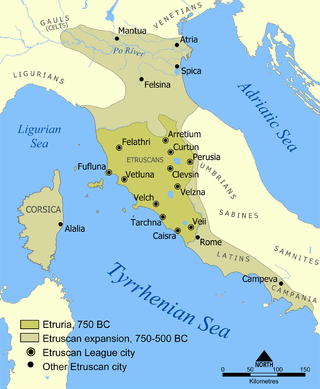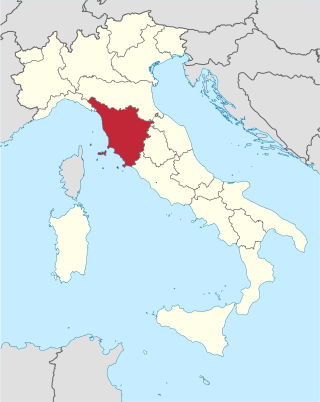Tuscan may refer to:
Tuscan may refer to:

The Etruscan civilization was developed by the Etruscans, a people who inhabited Etruria in ancient Italy, with a common language and culture who formed a federation of city-states. After conquering adjacent lands, its territory covered, at its greatest extent, roughly what is now Tuscany, western Umbria, and northern Lazio, as well as what are now the Po Valley, Emilia-Romagna, south-eastern Lombardy, southern Veneto, and western Campania.
Etruscan may refer to:

Sassarese is an Italo-Dalmatian language and transitional variety between Sardinian and Corsican. It is regarded as a Corso–Sardinian language because of Sassari's historic ties with Tuscany and geographical proximity to Corsica. Despite the robust Sardinian influences, it still keeps its Corsican roots, which closely relate it to Gallurese; the latter is linguistically considered a Corsican dialect despite its geographical location, although this claim is a matter of controversy. It has several similarities to the Italian language, and in particular to the old Italian dialects from Tuscany.

Sangiovese is a red Italian wine grape variety that derives its name from the Latin sanguis Jovis, "the blood of Jupiter". Though it is the grape of most of central Italy from Romagna down to Lazio, Campania and Sicily, outside Italy it is most famous as the only component of Brunello di Montalcino and Rosso di Montalcino and the main component of the blends Chianti, Carmignano, Vino Nobile di Montepulciano and Morellino di Scansano, although it can also be used to make varietal wines such as Sangiovese di Romagna and the modern "Super Tuscan" wines like Tignanello.
Pisa is a city in Tuscany, Italy.

The Lunigiana or Lunesana is a historical territory of Italy, which today falls within the provinces of Massa Carrara, Tuscany, and La Spezia, Liguria. Its borders derive from the ancient Roman settlement, later the medieval diocese of Luni, which no longer exists.

The Tuscan order is one of the two classical orders developed by the Romans, the other being the composite order. It is influenced by the Doric order, but with un-fluted columns and a simpler entablature with no triglyphs or guttae. While relatively simple columns with round capitals had been part of the vernacular architecture of Italy and much of Europe since at least Etruscan architecture, the Romans did not consider this style to be a distinct architectural order. Its classification as a separate formal order is first mentioned in Isidore of Seville's Etymologies and refined during the Italian Renaissance.
Regional Italian is any regional variety of the Italian language.

Tuscan is a set of Italo-Dalmatian varieties of Romance spoken in Tuscany, Corsica, and Sardinia.

Central Italy is one of the five official statistical regions of Italy used by the National Institute of Statistics (ISTAT), a first-level NUTS region, and a European Parliament constituency.

Italo-Western is, in some classifications, the largest branch of the Romance languages. It comprises two of the branches of Romance languages: Italo-Dalmatian and Western Romance. It excludes the Sardinian language and Eastern Romance.
The Tuscan gorgia is a phonetic phenomenon governed by a complex of allophonic rules characteristic of the Tuscan dialects, in Tuscany, Italy, especially the central ones, with Florence traditionally viewed as the center.
Tosco may refer to:
Tuscany is one of the 20 regions of Italy.

Tuscan wine is Italian wine from the Tuscany region. Located in central Italy along the Tyrrhenian coast, Tuscany is home to some of the world's most notable wine regions. Chianti, Brunello di Montalcino and Vino Nobile di Montepulciano are primarily made with Sangiovese grape whereas the Vernaccia grape is the basis of the white Vernaccia di San Gimignano. Tuscany is also known for the dessert wine Vin Santo, made from a variety of the region's grapes. Tuscany has forty-one Denominazioni di origine controllata (DOC) and eleven Denominazioni di Origine Controllata e Garantita (DOCG). In the 1970s a new class of wines known in the trade as "Super Tuscans" emerged. These wines were made outside DOC/DOCG regulations but were considered of high quality and commanded high prices. Many of these wines became cult wines. In the reformation of the Italian classification system many of the original Super Tuscans now qualify as DOC or DOCG wines but some producers still prefer the declassified rankings or to use the Indicazione Geografica Tipica (IGT) classification of Toscana. Tuscany has six sub-categories of IGT wines today.

Tuscany is a region in central Italy with an area of about 23,000 square kilometres and a population of about 3.8 million inhabitants. The regional capital is Florence (Firenze).

Emilian is a Gallo-Italic unstandardised language spoken in the historical region of Emilia, which is now in the northwestern part of Emilia-Romagna, Northern Italy.
Toscano, Tuscano, Toscana, Toscani or Toscanelli may refer to:

In classical antiquity, several theses were elaborated on the origin of the Etruscans from the 5th century BC, when the Etruscan civilization had been already established for several centuries in its territories, that can be summarized into three main hypotheses. The first is the autochthonous development in situ out of the Villanovan culture, as claimed by the Greek historian Dionysius of Halicarnassus who described the Etruscans as indigenous people who had always lived in Etruria. The second is a migration from the Aegean sea, as claimed by two Greek historians: Herodotus, who described them as a group of immigrants from Lydia in Anatolia, and Hellanicus of Lesbos who claimed that the Tyrrhenians were the Pelasgians originally from Thessaly, Greece, who entered Italy at the head of the Adriatic sea in Northern Italy. The third hypothesis was reported by Livy and Pliny the Elder, and puts the Etruscans in the context of the Rhaetian people to the north and other populations living in the Alps.
The Italo-Dalmatian languages, or Central Romance languages, are a group of Romance languages spoken in Italy, Corsica (France), and formerly in Dalmatia (Croatia).